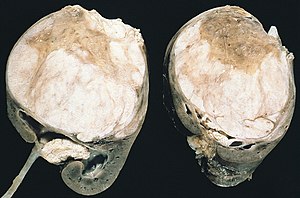Wilms tumour
| Wilms' tumor | |
|---|---|
| Synonyms | Wilms' tumor |
 |
|
| Cut section showing two halves of a nephroblastoma specimen. Note the prominent septa subdividing the sectioned surface and the protrusion of tumor into the renal pelvis, resembling botryoid rhabdomyosarcoma. | |
| Pronunciation | |
| Classification and external resources | |
| Specialty | Oncology |
| ICD-10 | C64 |
| ICD-9-CM | 189.0 |
| ICD-O | M8960/3 |
| OMIM | 194070 607102 |
| DiseasesDB | 8896 |
| MedlinePlus | 001575 |
| eMedicine | med/3093 ped/2440 |
| MeSH | D009396 |
Wilms tumor, also known as nephroblastoma, is a cancer of the kidneys that typically occurs in children, rarely in adults. It is named after Dr. Max Wilms, the German surgeon (1867–1918) who first described it.
Approximately 500 cases are diagnosed in the U.S. annually. The majority (75%) occur in otherwise normal children; a minority (25%) are associated with other developmental abnormalities. It is highly responsive to treatment, with about 90% of patients surviving at least five years.
Typical signs and symptoms of Wilms' tumor include the following:
Most nephroblastomas are on one side of the body only and are found on both sides in less than 5% of cases, although patients with Denys-Drash syndrome mostly have bilateral or multiple tumors. They tend to be encapsulated and vascularized tumors that do not cross the midline of the abdomen. In cases of metastasis it is usually to the lung. A rupture of Wilms tumor puts the patient at risk of bleeding and peritoneal dissemination of the tumor. In such cases, surgical intervention by a surgeon who is experienced in the removal of such a fragile tumor is imperative.
Pathologically, a triphasic nephroblastoma comprises three elements:
Wilms tumor is a malignant tumor containing metanephric blastema, stromal and epithelial derivatives. Characteristic is the presence of abortive tubules and glomeruli surrounded by a spindled cell stroma. The stroma may include striated muscle, cartilage, bone, fat tissue, fibrous tissue. Dysfunction is caused when the tumor compresses the normal kidney parenchyma.
The mesenchymal component may include cells showing rhabdomyoid differentiation or malignancy (rhabdomyosarcomatous Wilms).
Wilms tumors may be separated into 2 prognostic groups based on pathologic characteristics:
Mutations of the WT1 gene on chromosome 11p13 are observed in approximately 20% of Wilms tumors. At least half of the Wilms tumors with mutations in WT1 also carry mutations in CTNNB1, the gene encoding the proto-oncogene beta-catenin.
...
Wikipedia
